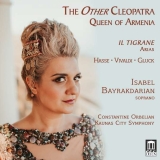 The Other Cleopatra. Queen of Armenia; Arien aus Il Tigrane von Hasse, Vivaldi & Gluck; Isabel Bayrakdarian, Sopran, Kaunas City Symphony Orchestra, Constantine Orbelian; 1 CD Delos DE3591; Aufnahme 09/2019, Veröffentlichung 20/03/2020 (64'06) - Rezension von Remy Franck
The Other Cleopatra. Queen of Armenia; Arien aus Il Tigrane von Hasse, Vivaldi & Gluck; Isabel Bayrakdarian, Sopran, Kaunas City Symphony Orchestra, Constantine Orbelian; 1 CD Delos DE3591; Aufnahme 09/2019, Veröffentlichung 20/03/2020 (64'06) - Rezension von Remy Franck
‘The Other Cleopatra’ stellt eine Königin in den Mittelpunkt, die in gut zwei Dutzend Opern eine Rolle spielt, Cleopatra von Pontus (110-58 vor Christus), eine der Töchter des Königs Mithridates VI. von Pontus. Sie heiratete den armenischen König Tigranes den Großen und nahm Einfluss auf die armenische Politik.
Auf der Grundlage seiner eigenen Interessen hatte Tigranes eine andere Außenpolitik gegenüber der römischen Republik als Mithridates und unterzeichnete schließlich einen Vertrag mit Rom. Unter dem Einfluss ihres Vaters stiftete Cleopatra ihre drei Söhne an, Tigranes zu bekämpfen. Die Söhne versuchten jedoch erfolglos, den Thron von Tigranes zu erobern. Zwei der Söhne ließ Tigranes schließlich töten. Ein weiterer Sohn konnte entkommen, genau wie Cleopatra, die zu ihrem Vater flüchtete, wo sie bis zu ihrem Tod lebte.
Drei Opern bzw. Opernfragmente hat die kanadisch-armenische Sängerin Isabel Bayrakdarian für ihr Programm bei Delos ausgewählt. Alle drei benutzen ein Libretto von Francesco Silvani (wobei es im Falle Vivaldis Zweifel daran gibt).
Tigrane von Johann Adolph Hasse wurde 1729 im Teatro San Bartolomeo in Neapel uraufgeführt. Vivaldis Tigrane wurde 1724 während des Römischen Karnevals im Teatro Capranica zum ersten Mal gespielt. Die Oper ist nicht vollständig erhalten.
Glucks Il Tigrane wurde 1743 in Crema uraufgeführt. Die drei Komponisten haben für die Rolle der Cleopatra brillante und technisch anspruchsvolle Arien komponiert, die Isabel Bayrakdarian leidenschaftlich und dramatisch singt. Ihre Stimme hat ein reiches Timbre mit warmer Höhe, viel Leuchtkraft und einer bemerkenswert sonoren Tiefe. Eine perfekte Beherrschung des Vibratos, eine überaus klare Artikulierung, feine Koloraturen und viele Farben erlauben ihr die Möglichkeiten des Ausdrucks gut zu variieren und treffende Charakterisierungen zu erzielen.
‘The Other Cleopatra’ focuses on a queen who plays a role in about two dozen operas, Cleopatra of Pontus (110-58 B.C.), one of the daughters of King Mithridates VI of Pontus. She married the Armenian King Tigranes the Great and influenced Armenian politics.
Based on his own interests, Tigranes had a different foreign policy towards the Roman Republic than Mithridates and eventually signed a treaty with Rome. Under the influence of her father, Cleopatra instigated her three sons to fight Tigranes. However, the sons tried unsuccessfully to conquer the throne of Tigranes. Tigranes finally had two of the sons killed. Another son escaped, as did Cleopatra, who fled to her father, where she lived until her death.
The Canadian-Armenian singer Isabel Bayrakdarian chose three operas or opera fragments for her program. All three use a libretto by Francesco Silvani (although in Vivaldi’s case there is some doubt about this).
Tigrane by Johann Adolph Hasse was first performed in 1729 at the Teatro San Bartolomeo in Naples. Vivaldi’s Tigrane was first performed at the Teatro Capranica during the Roman Carnival in 1724. The opera is not completely preserved.
Gluck’s Il Tigrane was created in Crema in 1743. The three composers wrote brilliant and technically demanding arias for the role of Cleopatra, which Isabel Bayrakdarian sings with passion and drama. Her voice has a rich timbre with warm high notes, a lot of luminosity and a remarkably sonorous depth. A perfect control of the vibrato, an extremely clear articulation, fine coloratura and many colours allow her to vary the possibilities of expression well and to achieve accurate characterizations.






















